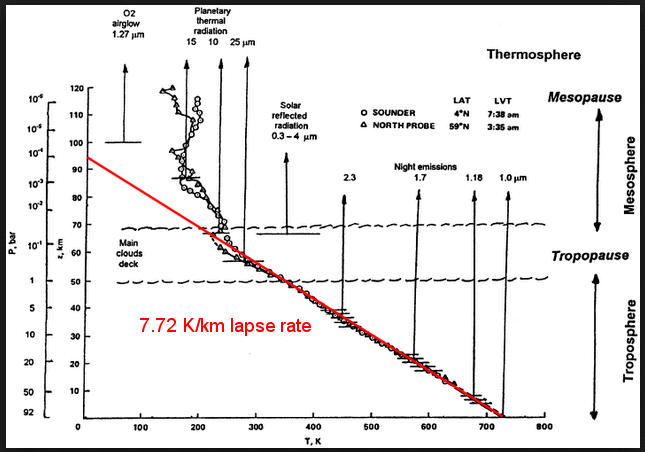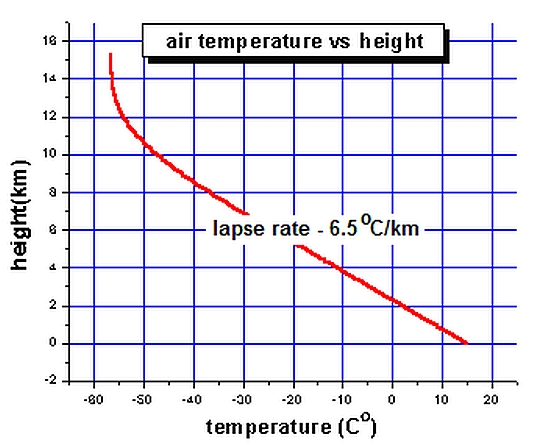Nearly every academic in the country believes that Venus is hot because of the large amount of CO2 in their atmosphere, which they say is “trapping the Sun’s heat.”
It is trivial to demonstrate that this theory is mindless nonsense.
The lapse rate on Earth is nearly the same as it is on Venus, despite the fact that the Venusian atmosphere has 95% GHG, and Earth’s atmosphere has less than 3% GHG.
Venus lapse rate is slightly higher than Earth, because CO2 is more dense than N2 or O2. Thus the atmospheric pressure increases at a higher rate as you descend through the atmosphere.
If GHG’s controlled the lapse rate on Earth, then humid days would have much higher lapse rates than dry days. In fact, we see the exact opposite. Humid days have slightly lower lapse rates than dry days, because H2O is less dense than N2 or O2. GHG’s have very little control of the temperature.
If GHG’s controlled the lapse rate on Earth, then the lapse rate would decrease with altitude, because there are more GHG’s near the surface. This doesn’t happen.
Venus surface receives very little sunlight. They go for months at a time in total darkness. yet the temperature doesn’t drop. How can anyone be stupid enough to believe that Venus is hot because of trapped sunlight?
Venus is hot because it has a very tall, high pressure troposphere. At 1000 mb in the Venusian atmosphere, temperatures are similar to Earth’s surface, despite a very different chemical makeup of the atmosphere.
The bottom of the Grand Canyon is hot because of high atmospheric pressure. The top of the Grand Canyon is cold because of low atmospheric pressure.
The combined IQ of academia on this subject is close to zero. Complete flaming idiots.




Even the so-called “settled science” behind global warming is flawed.
A lapse in logic about the lapse rate lapses into a permanent relapse, that’s settled.
you made my day.
“because there are more GHG’s near the surface” – Source? Composition is fairly constant, and what little variation there is in the noise isn’t it? 3rd order effect or lower WRT radiative balance I would think…
There is much more water vapor in the lower troposphere than higher up.
…and as stated, it makes no difference in the lower troposphere, as in a dense atmosphere conduction through collisions rule, being far faster, the molecules simply do not have a chance to radiate.
“Composition is fairly constant”
Imagine an atmosphere where the composition (based on percentages) is absolutely identical throughout. Will you find more GHGs where the atmosphere is more dense (near the surface)?
“Composition is fairly constant” is another one of the CAGW BIG LIES!
CO2 is heavier than air. Plants suck it down, hot water releases CO2, cold water sucks it down, Volcanoes releas it, plants release CO2 at night…..
So what is mixing these gases to a ‘uniform’ complsition? A mix master?
(Have to leave shortly. If needed I will address this more thoroughly later.)
In climate science you only need one guy to get it right.
Which is me. Of course.
This lapse rate stuff is what gets you kicked off LGF blog site. Charles Johnson knows nothing of lapse rate.
Serious question: If the atmosperic pressure drives the temperature, why is it so cold in death valley or bottom of the grand canyon at night?
Because CO2 is a poor greenhouse gas;)
Low humidity?
Because just like in the mountains, the denser cold air runs downhill at night. It is strongest in the drawls and in restricted steep drawls it can become a pretty good breeze. We would set up shelters to keep the cool breeze from chilling us at night during the autumn. To get an enhanced effect that starts quicker and is colder try camping out below a glacier above the tree line some time and you’ll experience a darn cool breeze coming down on you within an hour after sunset.
The experienced mountaineer learns these things and accounts for them or even uses them to his advantage.
The specific energy of the air.
A dry atmosphere and ground has a much lower specific energy, allowing it to heat up and COOL DOWN much more rapidly in response to incoming solar energy.
Water in it’s different forms, allows the atmosphere to retain energy because of latent and specific energy.. and its is the only substance is sufficient quantity to do so.
CO2 has an absolutely immeasurable effect on the specific energy of the atmosphere.
Earth’s lapse rate is similar to that on Venus because the Cp (Specific Heat at constant pressure) of the Nitrogen that represents 80% of our atmosphere is close to that of CO2 that represents 97% of the Venusian atmosphere. Carl Sagan figured this out in 1967.
https://stevengoddard.wordpress.com/2014/03/06/please-stop-the-stupid/#comment-324643
DALR (Dry Adiabatic Lapse Rate) = -g/Cp
Venus has a surface g of 8.83 m/second^2 while Earth’s g =9.81m/second^2 which lowers the Venusian lapse rate by ~10%.
The above equation can be proved using thermodynamics but more complex radiative/convective models give the same answer:
http://www.nature.com/ngeo/journal/v7/n1/abs/ngeo2020.html
Hi Camel,
Did you get a chance to look at Dr Happer’s lecture and slides?
video: http://jlf.streamhammer.com/speakers/williamhapper090814.mp4” /
David Burton put up an audio video and slides of Dr Happer’s presentation at this. link
SLIDES: link
Slides 16, 22, 42, 43 and 44 are the critical slides IMHO.
He says the same thing as Dr. Brown
The Super Mandias confirms. (Snicker)
http://www2.sunysuffolk.edu/mandias/global_warming/images/stratospheric_cooling.jpg
Specific heat is largely controlled by molecular weight.
KE = 1/2 * m * v^2
A few additional points are worth making. The basic cause of the lapse rate is the requirement that energy (kinetic + potential) be conserved in a gravitational field. Lapse rates are observed in every atmosphere, even stars and the Sun where the lapse rate is about 11 C/km in the upper photosphere. There are no greenhouse gases in the Sun.
IPCC science says the atmosphere will be isothermal if there are no greenhouse gases present. They contend that the 33 C difference between surface temperature and planetary temperature is caused entirely by greenhouse gases. The 33 C cannot be correct, because they neglect the lapse rate caused by gravity. Thus, the claimed 33 K is much too large and the claimed no-feedback climate sensitivity of about 1.1 C per doubling is incorrect. The actual climate sensitivity is likely very small.
@Gail Combs,
Thanks for those links. Somehow I missed Happer at UNC.
I have debated “rgb” and agree with his take on LWIR in the lower atmosphere. While “rgb” is right, his arguments are qualitative. I find Robinson & Catling more helpful as they get into the numbers and then test their (mathematical) model on all seven bodies in our solar system.
@Douglas Hoyt,
That 33 K “Greenhouse Effect” is bogus. The GHE is much larger given that Earth’s average temperature would probably be nearer 197 K than 255 K “sans atmosphere”.
“Climate Scientists” proved that an airless Earth would have an average temperature of 255 K using flawless mathematics. Unfortunately they made bad assumptions about the surface properties of planets so they were (as usual)………………WRONG.
https://tallbloke.wordpress.com/2014/04/18/a-new-lunar-thermal-model-based-on-finite-element-analysis-of-regolith-physical-properties/
So we know the Moon’s average temperature but would the temperature of an airless Earth be 197.3 K? Earth’s rate of rotation is 29.5 times greater than that of the Moon. Would that change the average temperature? If so by how much?
My calculations show that a higher rate of rotation raises the temperature but I am an amateur and several professionals disagree. Tim Channon over at “Tallbloke” should be publishing something shortly. It will be interesting to see how far apart the estimates are. You can bet nobody will be claiming anything close to the discredited 255 K.
Most of the sunlight that Venus absorbs is absorbed by the SO2 clouds, which are blackbodies. It’s absurd to think that Venus’ atmosphere is hot because CO2 absorbs IR from the surface in that little 15 micron band, when blackbodies absorb all wavelengths of IR, UV, and visible light, on the way in. You can’t see the surface of Venus, it’s blocked by the SO2 clouds. Venus is hot because the sunlight heats the atmosphere directly, and this heat is transferred to the surface because of pressure according to PV = nRT
This is totally different from Earth, which absorbs most of the sunlight at the surface, mainly by the oceans. That’s why the daylight side of Earth is always warmer than the night side. Not true of Venus, which is heated on both sides (and poles) equally.
I like to think of the Venus atmosphere being non-tenuous, therefore the pressure gradient rules almost completely….
while Earth’s atmosphere is sort of semi-tenuous, so we get a mix of stability and fluctuations due to the mix of influence of the pressure gradients and the solar energy/magnetic input.
The Moon, and Mars are highly tenuous and are driven mostly by the direct sunlight
What is actually stupid are people who think that pressure generates heat adiabatically as if by magic. Really quite close to infinity stupid are those who think that their crank garage physics is better than that of actual trained astronomers and physicists.
“What is actually stupid are people who think that pressure generates heat adiabatically as if by magic. Really quite close to infinity stupid are those who think that their crank garage physics is better than that of actual trained astronomers and physicists.”
It is not pressure that generates heat and no one is arguing that way.
What is being said that energy is conserved in the presence of a gravitational field and this leads to an adiabatic lapse rate (ignoring the complication of evaporation and condensation for the moment).
When you toss a ball (or a molecule) up, does it slow down or does it maintain the same velocity no matter how high it is thrown?
IPCC answer: it maintains the same velocity and hence same temperature independent of height. The atmosphere is isothermal in their view.
Physicist answer: the ball or molecule slows down. Its energy (kinetic plus potential) is conserved. The Loschmidt Effect expresses this effect mathematically. The energy to heat the atmosphere comes primarily from surface heat, which comes from the sun. It has nothing to do with the idea of compression like a pump.
The physicist’s answer is correct.
The IPCC’s incorrect contention that the atmosphere is isothermal, unless one adds a greenhouse gas, leads them to conclude that the 33K difference between the surface temperature (288K) and top the atmosphere temperature (255K) is caused 100% by greenhouse gases. That is wrong!
A dry atmosphere would lead to an approximately 53K difference between the surface and top of the atmosphere. A secondary effect is evaporation from the surface and condensation higher up which reduces the lapse rate to close to 33K. A tertiary and very weak effect is the so-called greenhouse effect, probably amounting to a few tenths of a degree at most for a doubling of carbon dioxide.
Since the claimed 33K warming by greenhouse gases is erroneous, the entire climate field is based upon an erroneous assumption.
Thanks for that succinct explanation. You never know when someone reading this blog might learn something new to them, when explained in that much detail.
+1
Very nice comment, Douglas Hoyt! Add in the overlap between H2O and CO2 as far as IR properties go, and the effect of added CO2 becomes too small to worry about.
Just for the record here:
There is no man made global warming
and you could have figured that out by monitoring the temperature in your own backyard
[for the past 40 years]
https://i0.wp.com/oi62.tinypic.com/33kd6k2.jpg